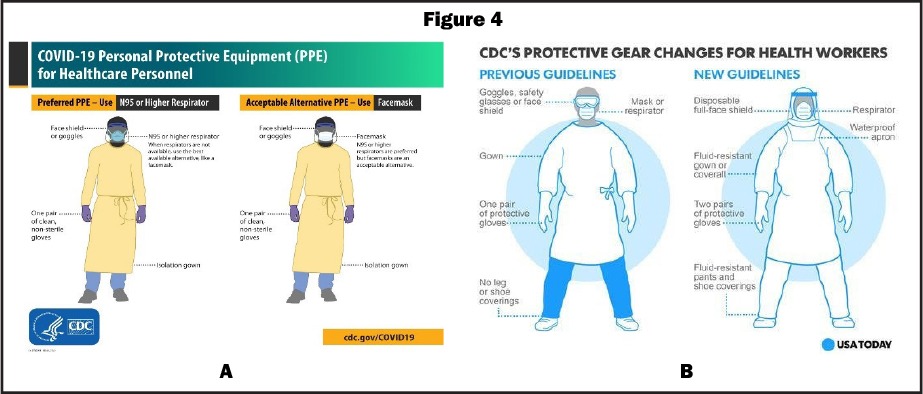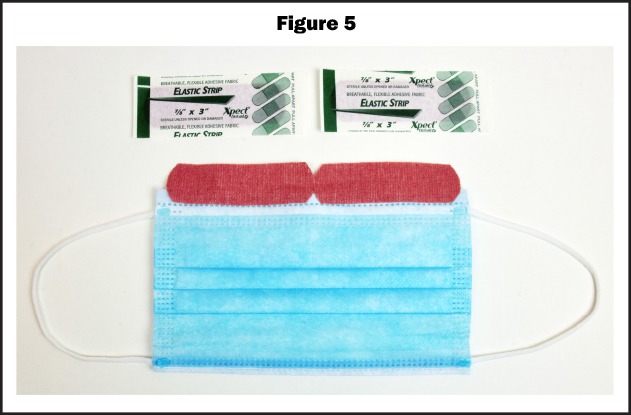Implementing Personal Protective Equipment (PPE) With Loupes and Headlights

ErgoPractice News – May 2020
By Jin Chang PhD
jchang@surgitel.com
Summary
- SurgiTel’s full-face shield (patent pending) and universal light mount with coaxial extender (patent pending) allow us to implement Personal Protective Equipment (PPE) with loupes and headlights in three different ways (Figure 1).
- Answers to questions related to other PPE implementation options and disinfectants are included below.
- And at the end of this issue, we list several reference literature you may review to implement infection control for your practice.
SurgiTel’s Implementation of PPE With Loupes and LED Headlights
 By improving the design of full-face shield (patent pending) and universal mounting clip with coaxial extenders (patent pending), SurgiTel can provide PPE with loupes and headlights in three different combinations (Figure 1):
By improving the design of full-face shield (patent pending) and universal mounting clip with coaxial extenders (patent pending), SurgiTel can provide PPE with loupes and headlights in three different combinations (Figure 1):
- Placing headlight attached to loupes behind the face shield. For this case, thick headband foam provides the necessary space. Reduced brightness on the target may occur due to the reflection by the inner surface of the face shield.
- Placing headlight attached to loupes through the hole of the face shield. In this case, the headlight is exposed to aerosols, but the heat of the headlight can kill viruses.
- Attaching headlight to the face shield with SurgiTel’s universal mounting clip. May use the coaxial extender for the best adjustability.
Contact your local SurgiTel Representative for an expert consultation and purchase. Please reach out soon, as supplies of this Face Shield customized for loupes are limited!
PPE Recommended by the Centers for Disease Control and Prevention (CDC)
 The coronavirus COVID-19 mainly spreads from person to person. When infected persons cough or sneeze, they send droplets or aerosols containing the virus into the air. Healthy persons can breathe in those droplets or aerosols. You may also catch the virus if you touch contaminated surfaces or objects and then touch your mouth, nose, or eyes without washing your hands. Figure 2 shows the transmission routes of the virus. It is noted that the virus can live for hours to days on surfaces such as countertops and doorknobs. How long depends on the material the surface is made from (Figure 3).
The coronavirus COVID-19 mainly spreads from person to person. When infected persons cough or sneeze, they send droplets or aerosols containing the virus into the air. Healthy persons can breathe in those droplets or aerosols. You may also catch the virus if you touch contaminated surfaces or objects and then touch your mouth, nose, or eyes without washing your hands. Figure 2 shows the transmission routes of the virus. It is noted that the virus can live for hours to days on surfaces such as countertops and doorknobs. How long depends on the material the surface is made from (Figure 3).
 To stop spreading the virus by aerosols, the Centers for Disease Control and Prevention (CDC) has provided guidance for healthcare professionals (HCP) on using Personal Protective Equipment (PPE).
To stop spreading the virus by aerosols, the Centers for Disease Control and Prevention (CDC) has provided guidance for healthcare professionals (HCP) on using Personal Protective Equipment (PPE).
Earlier the CDC recommended a mask or respirator, gown, and goggle or face shield (Figure 4a). CDC’s newest recommendation changed “goggles or face shield” to “disposable full-face shield” and “mask or respirator” to “respirator” (Figure 4b).1 (Note that N95 or equivalent face masks are considered respirators.)

Questions and Answers
Question #1: Will SurgiTel offer loupes with goggles?
Answer: SurgiTel investigated various goggles for loupes. There are two issues. Goggles do not allow good loupe ergonomics and they create fogging problems. If a full-face shield is used, goggles are not necessary. With face shields, aerosols cannot reach loupes, face masks, and eyes.
Question #2: Will SurgiTel offer a flip-up style face shield?
Answer: Flip-up face shields design cannot stop aerosols reaching your loupes and face because they have a large opening at the top. SurgiTel will continue to investigate various design options. Currently, we recommend full-face shields that do not flip-up.
 Question #3: When I wear a mask, I have a fogging problem with my loupes/face-shield. How can I eliminate this problem?
Question #3: When I wear a mask, I have a fogging problem with my loupes/face-shield. How can I eliminate this problem?
Answer: First you should select a proper style of N95. If the N95 mask is properly fitted, the fogging problem will be eliminated. The CDC and ADA provide fitting & testing instructions.1, 4 If your mask is a non-respiratory mask, you can add band-aids at the top edges of your mask (Figure 5).
Question #4: Can we use UV light to disinfect loupes?
Answer: You can use UV light to disinfect loupes if the disinfecting equipment was tested as infection control equipment, but we have not tested any specific UV disinfecting equipment on loupes.
Question #5: Can hand sanitizer with high alcohol content be used to disinfect loupes and light cables?
Answer: CR Foundation tests showed that hand sanitizers with high alcohol content is very effective in killing viruses.5, 6 Our tests showed that hand sanitizers with “Isopropanol” degrades the glue used for mounting TTL loupes. It is noted that hand sanitizers with “ethyl alcohol (ethanol)” can damage loupes.
Contact your local SurgiTel Representative at for an expert consultation.
References and Resources:
- Using personal protective equipment (PPE) recommended by CDC: https://www.cdc.gov/coronavirus/2019-ncov/hcp/using-ppe.html
- Personal protective equipment (PPE): questions and answers by CDC: https://www.cdc.gov/coronavirus/2019-ncov/hcp/respirator-use-faq.html
- Sequence of putting on personal protective equipment by CDC: https://www.cdc.gov/niosh/research-rounds/images/cdcProcedures.jpg
- ADA guidance of fitting N95 masks: https://success.ada.org/~/media/CPS/Files/COVID/Conducting_Respirator_Fit_Tests_And_Seal_Checks.pdf
- 1378 COVID-19 Coronavirus Guidance from Drs. Gordon and Rella Christensen by DentalTown : Dentistry Uncensored: https://www.youtube.com/watch?v=cA_mHj0BEuI
- Infection control and PPE after COVID-19 by Dr. Gordon Christensen: https://www.youtube.com/watch?v=_IltoyYgZtA
- COVID-19 & Dentistry: Returning to Practice: A Walkthrough of the ADA’s Guidance & Aerosol Management: https://www.youtube.com/watch?v=KdI3POwfvK0
- Droplet and Airborne Transmission Precautions for the Dental Team by American Dental Association (ADA): https://www.youtube.com/watch?v=uB0JzgMMn3g
- OSAP Experts Answer Dental Community Questions About PPE by ADA: https://www.youtube.com/watch?v=vp90geAyjTE
- COVID-19 & Dentistry: Clinical Update with Dr. Reznik by Henry Schein Dental: https://www.youtube.com/watch?v=NOp-aMfwxFs
Please note General Scientific Corporation is not legally responsible for any outcomes from the implementation of our recommendations. General Scientific Corporation is offering the best information and advice available to our team at this time. All working professionals should first and foremost follow all CDC recommendations. Visit the CDC site at www.cdc.gov



